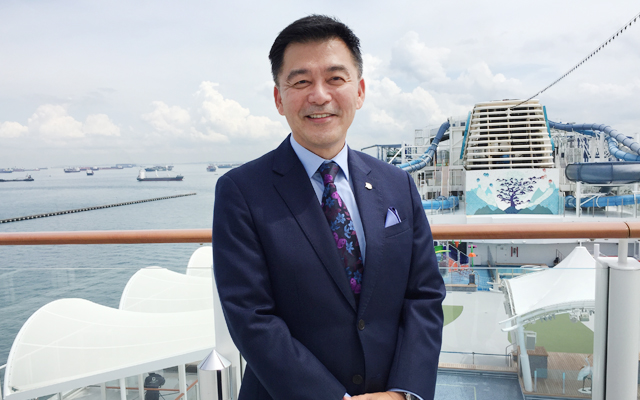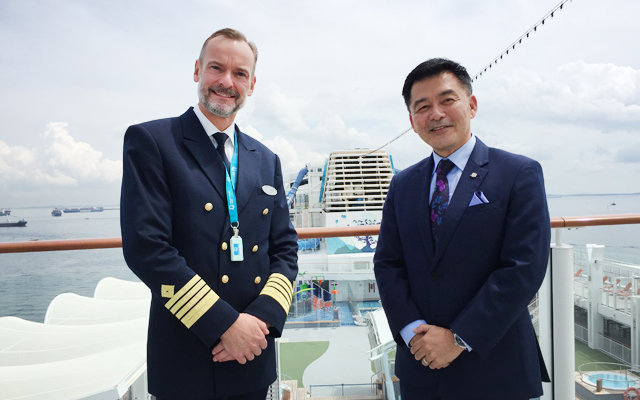Rebooting sailings from Singapore, Dream Cruises’ World Dream has been operating pilot cruises to nowhere with enhanced safety protocols. Michael Goh, president of Dream Cruises and head of international sales, Genting Cruise Lines, details the brand’s battle plan and how their business continuity is anchored in adaptability and agility

Ahead of World Dream’s restart of Singapore sailings, Genting Cruise Lines has invested in new equipment such as handwashing machines as part of its Covid-19 response. What are the costs associated with fulfilling Covid-safe regulations?
The costs now versus pre-Covid has actually increased by 40 per cent because we are using hospital-grade chemicals (for cleaning and disinfecting of premises), and also have an expensive PCR machine onboard the ship, among others.
Dream Cruises’ pilot sailings will comply with Singapore Tourism Board (STB)’s mandatory CruiseSafe certification programme, jointly developed with quality assurance and risk management company DNV GL. How will the cruise experience change as a result of these new protocols in the initial recommencement of sailings?
Obviously, there are certain things that are mandatory, like before passengers board the ship, they have to do the antigen test. And they have to follow the protocols of safe distancing, frequent washing of hands and all. So, these basic rules (on land) will apply onboard the ship. But many of these executions are done behind-the-scenes by the ship team, and our responsibility is to make sure that the guests have a good time.
What do you reckon poses the greatest hindrance or challenge to rebuilding the cruise tourism industry in Asia?
Of course, before (travellers) go on a holiday, the first thing that comes to mind is how safe it is. So, we need to get a very clear message across to the consumer that, in fact, cruising is one of the safest (forms of travel) with so many precautionary measures in place.
The second part is for us to continue to demonstrate to (potential cruisers) that their holiday experience is not being compromised (even with Covid-safe measures). When you talk about staycations in Singapore, you basically stay in the hotels and go to the pool and all that. But onboard the cruise ship, we are providing (guests) with an integrated experience, meaning that their (meals) are being looked after and shows are being included. I think the beauty about cruising is that families or friends are able to spend quality time together. So that element – and attractiveness – of cruising has not changed.
According to a recent online poll conducted by a local media outlet, nearly half of the 1,000 respondents expressed a lack of confidence about new safety protocols rolled out on cruises to nowhere. What more can be done by the cruise and tourism industry, including travel agents, to dispel wrong mindsets and convince this segment of the public about the safety of cruising?
By setting the example of (being the world’s first cruise brand to resume post-pandemic operations in) Taiwan, and having completed 37 cruises taking 47,000 passengers, (we have showcased) a testimonial of consumers’ confidence. And with an overall rating of 4.7 over 5 (in terms of passenger satisfaction), it also represents that their experience is good. So, now with the restart of cruising in Singapore, we want to convey a positive message to the consumers here and around the world, and regain cruise confidence.
During this time, we also continue to train our travel partners – through webinars and various cruise forums that have taken place in Singapore recently – because travel agencies continue to be one of our important booking channels… Also, if you go to our social media platforms, you will see that we (feature) many bloggers who continue to blog about the beauty (of cruising) and how enjoyable it is.

Will there be any difference between the protocols onboard the Taiwan sailings versus the Singapore Seacations?
Whether in Singapore or Taiwan, besides the international (safety) standards, we also have to comply with local requirements. So, there are some differences between (cruise safety protocols in) Taiwan and Singapore. I think Singapore has a very complex system, and the various ministry task forces have joined hands with STB to work with us to provide guidelines and advice, and also look at how they can marry our operating procedures together with hygiene protocols to provide a safe environment.
What are some of the key takeaways that the cruising industry has learnt from managing this global crisis over the past ten months?
In any business, including the cruise business, we always got to review and implement. What works today might not tomorrow. Like, for example, today, we do the antigen test. Maybe in a couple of weeks, if there is a new method of testing that is effective and more comfortable for guests, we will change immediately. The strength of Dream Cruises or Genting Cruise Lines is our ability to adapt to changes very quickly. I think this is really very important in today’s business environment. We just got to be vigilant all the time.
These pilot cruises will pave the way for a broader resumption of cruising activities. Looking ahead, what does Genting Cruise Lines have in store for when travel restrictions eventually ease?
Cruises to nowhere is not anything new because during pre-Covid times, we also have cruises to high seas. But what is different now is that we cannot call into other ports, and people have been locked down for a long time. So, they really want a holiday. Staycation doesn’t answer to their (desire for a vacation). But the Super Seacation will, because when the ship sails off, it gives you the feeling that you are really going on a holiday. Before Covid, one may have gone on holiday four times a year. But if I were to ask you now: “Where have you gone on holiday in the last ten months?” Nowhere, right? So that really changes the landscape in terms of a holiday concept.
But we can’t be running these cruises to nowhere forever. When the situation improves, we will go back into the regional and global cruising market – and we believe that will be in the near future.




















